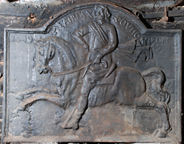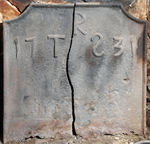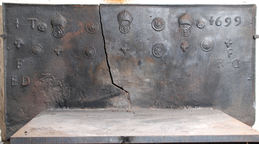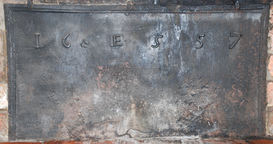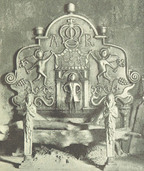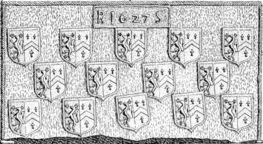-
1023
Description: Canted rectangle; hatched fillet edging (top and sides); initials in triad to the left; fleur-de-lys stamp repeated seven times across top; date and initial pairs below; full width, horizontal hatched fillet below inscription; zig-zag formed of short, hatched fillets down each side below horizontal fillet; space within bordered by squared cross stamp repeated 12 times horizontally and six times on each side.
Notes: The distinctive squared cross and fleur stamps are seen on other firebacks; the initials in triad may relate to a husband and wife, the pairs of initials to their children; an almost identical fireback (no. 1314) seen at Smith's Funeral Services, close to the site of Elmbridge Furnace, at Newent, Gloucestershire, differs only in the alignment of the left-hand column of squared crosses.
Inscription: AHE [triad] 1671 WH MH
- Decoration tags:
- rectangular with canted top corners (shape)
- hatched fillet (edging)
- simple stamps
- carved stamps
- individual letters
- individual numbers
- heraldic
- text
- objects
Manufactured: in 1671 possibly at Elmbridge Furnace, Newent in the Forest of Dean area of England.
Current location: in private hands, Coombes, West Sussex, England.
- Attached to series:
- Date & initials firebacks
- Newent area group
- Square cross Dean series 1
-
1035
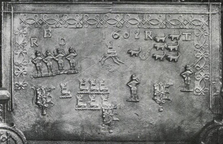 ? x ? mm
? x ? mmDescription: Rectangular with furniture-derived mounding (top and sides); double-loop 'lens' pattern stamp repeated inside the moulded edging nine times along the top and three times down each side; top left, initials RBD in triad; right of top centre, date 1602; top right, initials RT split between two repeated dog stamps; four other dog stamps in pairs below, and one below date; becapped human figure stamp, with his left arm raised to his head and his right arm akimbo, repeated four times below initial triad and two singly, one below lone dog stamp and one centre right; top centre, stamp of a crest formed of a stag 'lodged' (i.e. sitting) upon a wreath, in this instance only with pseudo legs drawn below, also repeated six times in two rows of three left of lower centre, with one to the left of the six; 'renaissance' shield bearing initials 'IE' linked with twisted cord, repeated lower left and right with a third bottom centre impressed partially over the centremost stag crest.
Notes: A fireback remarkable for the haphazard arrangement of groups of seemingly unrelated stamps. Acquired in 1900 by Sir Spencer Maryon-Wilson for Charlton House (Country Life, 23 April 1904, from whence has come the illustration); several of the stamps have been noted on two other firebacks, both dated 1617, and suggesting by their location an origin in the Horsham area of the Weald.
Inscription: R B D [triad] 1602 R T / IE IE / IE
- Decoration tags:
- rectangular (shape)
- furniture moulding (edging)
- carved stamps
- heraldic
- monogram
- text
- animals
- humans
Manufactured: in 1602 in the Weald area of England.
Current location: not known.
Citation: Gardner, J. S., 30 Apr 1904, 'An old fire-back' (letter), Country Life, p. 647.
Citation: S. M. W. [Spencer Maryon-Wilson], 23 Apr 1904, 'An old fireback' [letter], Country Life, p. 611.
Citation: Shuffrey, L. A., 1912, The English Fireplace, London, Batsford.
-
1221
 ? x ? mm
? x ? mmDescription: Arched rectangular central panel with bead on broad fillet edging; lattice basket standing on a ground, with flowers and fruit issuing therefrom in a symmetrical display; arched rectangular border with fillet edging; on each side, mirrored vine with flowers and leaves suspended from mirrored swirled foliage; at the bottom, the letter W in a cartouche between swirled foliage; on top, mirrored swirled foliage issuing upwards from a mythical creature on each shoulder.
Notes: The floral theme and its execution shows parallels with the SHR, N and 1724 series of firebacks and could be from the same workshop. The 'W' initial probably denotes the pattern maker.
Inscription: W
Manufactured: in the late-17th to early-18th century in England.
Current location: not known.
Citation: Anon., 2 Dec 1905, 'Old Kent and Sussex Fire-backs', Country Life, pp. 767-768.
- Attached to series:
- W series
- British 'Dutch' style firebacks
- Fruit basket firebacks
-
37
Description: Arched rectangular shaped; cavetto moulded edging; male figure in dress of the period, right hand on hip, left hand holding reins, astride a prancing horse; date and inscription (letter 'N' reversed) follow inside top edge.
Notes: Thomas Fairfax, 3rd Lord Fairfax of Cameron (1612-1671), commander of the New Model Army, which probably prompted the epithet, conqueror. 1649 was the year of Charles I's execution, to which Fairfax was opposed.
Copies of this fireback are known.
Inscription: 1649 LD FAIRFAX COVNQVIROR
- Decoration tags:
- rectangular with round arch (shape)
- cavetto (edging)
- whole carved pattern
- pictorial
- historical
- text
- animals
- humans
Manufactured: in 1649 in England.
Current location: in private hands, Cowbeech, East Sussex, England.
- Attached to series:
- Commemorative firebacks
-
968
Description: Rectangular; truncated egg and dart moulded edging on top and left side; top right of centre, date in individual over-pressed stamps; initials in over-pressed stamps centred below date.
Notes: A rare use of egg and dart moulding used as separate edging, presumably derived from redundant domestic moulding or furniture.
Inscription: 1637 / H V
- Decoration tags:
- rectangular (shape)
- egg and dart (edging)
- individual letters
- individual numbers
- text
Manufactured: in 1637 possibly in the Weald area of England.
Current location: in private hands, Cowden, Kent, England.
- Attached to series:
- Date & initials firebacks
-
969
Description: Cavetto-canted rectangular shape; astragal edging (top and sides); letters in triad between separated date.
Notes: The modest size of this fireback reflects the decreasing size of fireplaces in the 18th century.
Inscription: 17 TRS [triad] 31
- Decoration tags:
- rectangular with canted top corners (shape)
- astragal (edging)
- individual letters
- individual numbers
- text
Manufactured: in 1731 in the Weald area of England.
Current location: in private hands, Cowden, Kent, England.
- Attached to series:
- Date & initials firebacks
-
887
Description: Rectangular; stepped fillet edging (top and sides), ending short of bottom of plate; rose and crown stamp repeated three times across top of plate, with initials 'IT' followed by a rose stamp to left, and a rose stamp followed by the date to right (1 or I crossed in both cases); concentric roundel stamp between each pair of rose and crown stamps; lower down, five small inverted fleurs-de-lys between four concentric roundels; below left, initials FED in triad; below right, FRD in triad (D reversed).
Notes: An alleged connection with the Tichborne family who lived at Crippenden in Cowden, Kent, may be justified if the initials, IT, refer to John Tichborne, the last of his family in the village, who died in 1708. The identities of those whose initials form the two triads is not known. The style of rose and crown is similar to that used in gun founding in the Tudor period, suggesting that the furnace that was the source of this fireback may have been used for that purpose.
Inscription: IT 1699 / EFD [triad] RFD [triad]
- Decoration tags:
- rectangular (shape)
- stepped fillet (edging)
- carved stamps
- individual letters
- individual numbers
- heraldic
- text
- objects
Manufactured: in 1699 in the Weald area of England.
Current location: Crippenden Manor, Cowden, Kent, England.
- Attached to series:
- 1660s-90s Wealden series
- Date & initials firebacks
-
38
Description: Rectangular; fillet and astragal edging; initials between date in one horizontal line, upper half of plate.
Inscription: 16 ES 57
- Decoration tags:
- rectangular (shape)
- astragal & fillet (edging)
- individual letters
- individual numbers
- text
Manufactured: in 1657 possibly in the Weald area of England.
Current location: Cowfold Cottage Tandoori, Cowfold, West Sussex, England.
- Attached to series:
- Date & initials firebacks
-
1210
Description: Individually designed quasi-arched rectangular shape; astragal edging; central portico with framed doorway and sloping roof, in which stands a male figure dressed in contemporary style; above the roof, the date, and above that, the initials TKM arranged in triad and around a flower head, this inscription enclosed within a five-sided ribbon compartment held at the top corners by a pair of mirrored dancing cherubs each of which holds in their outer hand a wand surmounted by a fleur-de-lys; below them are mirrored vine designs terminating in a grape bunch, and below each of them a mirrored swirled snake, its head reversed; towards the outer side of these snakes are a pair of mirrored birds within a curved cartouche of slightly raised relief that is associated with a swirl on each side of the fireback that terminates the astragal edging on each side and which ascends via a step surmounted by a miniature urn on each shoulder of the back to the top which is surmounted by an acorn shape; above the ribbons held by the cherubs, is a stylised crown between the initials AR; the above features are limited by a horizontal astragal, though the portico descends below it, and which is supported at each end by a simple Doric column enclosing the bottom panel which is otherwise plain.
Notes: The initials AR are of Anna Regina - Queen Anne. Finely cast but of naïve design, another fireback of the same design but with different inscriptions and dated 1723 is Bowness on Windermere. Illustration from Cowper, 1899, p.179.
Inscription: A R / TKM [triad] / 1714
- Decoration tags:
- rectangular with round arch (shape)
- astragal (edging)
- whole carved pattern
- individual letters
- individual numbers
- heraldic
- mythological
- text
- humans
- plants
Manufactured: in 1714 possibly at Backbarrow Furnace in the Furness area of England.
Current location: Low Graythwaite Hall, Hawkshead, Cumbria, England.
- Attached to series:
- Date & initials firebacks
- Rawlinson series
-
1007
Description: Rectangular; twisted rope edging on top and sides; cavetto-moulded-edged rectangle top centre, enclosing date between initials; 14 shields of Ayloffe impaling Sulyard arranged 5-4-5; Ayloffe: sable, a lion rampant Or, collared gules, between three crosses formy of the second; Sulyard: argent, a chevron gules between three pheons inverted sable.
Notes: William Ayloffe (c1535-1584) of Bretons, Hornchurch, Essex, Justice of the Court of Queen's Bench, married (c1560) Jane, dau. of Sir Eustace Sulyard, of Runwell, Essex. A large number of variants use the same shields; this example, unusually, has the initials RS instead of the more common CT. Illustration from Cowper (1911). Previously at Loddenden, Staplehurst, and before that at Great Cheveney, Marden, Kent.
Inscription: R 1627 S
Arms: Ayloffe impaling Sulyard (William Ayloffe of Bretons, Hornchurch)
- Decoration tags:
- rectangular (shape)
- rope (edging)
- carved stamps
- individual letters
- individual numbers
- armorial
- text
Manufactured: in 1627 possibly at Hawkhurst Furnace in the Weald area of England.
Current location: not known.
- Attached to series:
- Ayloffe series
- Personal armorial firebacks

